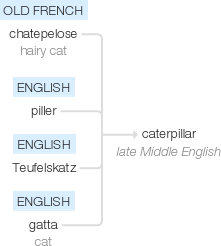Caterpillar
late Middle English: perhaps from a variant of Old French chatepelose, literally ‘hairy cat’, influenced by obsolete piller ‘ravager’. The association with ‘cat’ is found in other languages, e.g. Swiss German Teufelskatz (literally ‘devil's cat’), Lombard gatta (literally ‘cat’). Compare with French chaton, English catkin, which resembles a hairy caterpillar.
wiktionary
From Middle English catirpel, catirpeller, probably from Old Northern French catepeluse (Modern French chatte + pileuse(“hairy cat”)), from Late Latin catta + pilōsa.
etymonline
caterpillar (n.)
"larva of a butterfly or moth," mid-15c., catyrpel, probably altered (by association with Middle English piller "plunderer;" see pillage (n.)) from Old North French caterpilose "caterpillar" (Old French chatepelose), literally "shaggy cat" (probably in reference to the "wooly-bear" variety), from Late Latin catta pilosa, from catta "cat" (see cat (n.)) + pilosus "hairy, shaggy, covered with hair," from pilus "hair" (see pile (n.3)).
Compare also French chenille "caterpillar," literally "little dog." A Swiss German name for it is teufelskatz "devil's cat." "The caterpillar has in many idioms received the name of other animals" [Kitchin, who cites also Milanese cagnon "little dog," Italian dialectal gattola "little cat," Kentish hop-dog, hop-cat, Portuguese lagarta "lizard."] Compare also American English wooly-bear for the hairy variety. An Old English name for it was cawelworm "cole-worm." Caterpillar tractor, one which travels on endless steel belts, is from 1908, so called from its way of moving.
